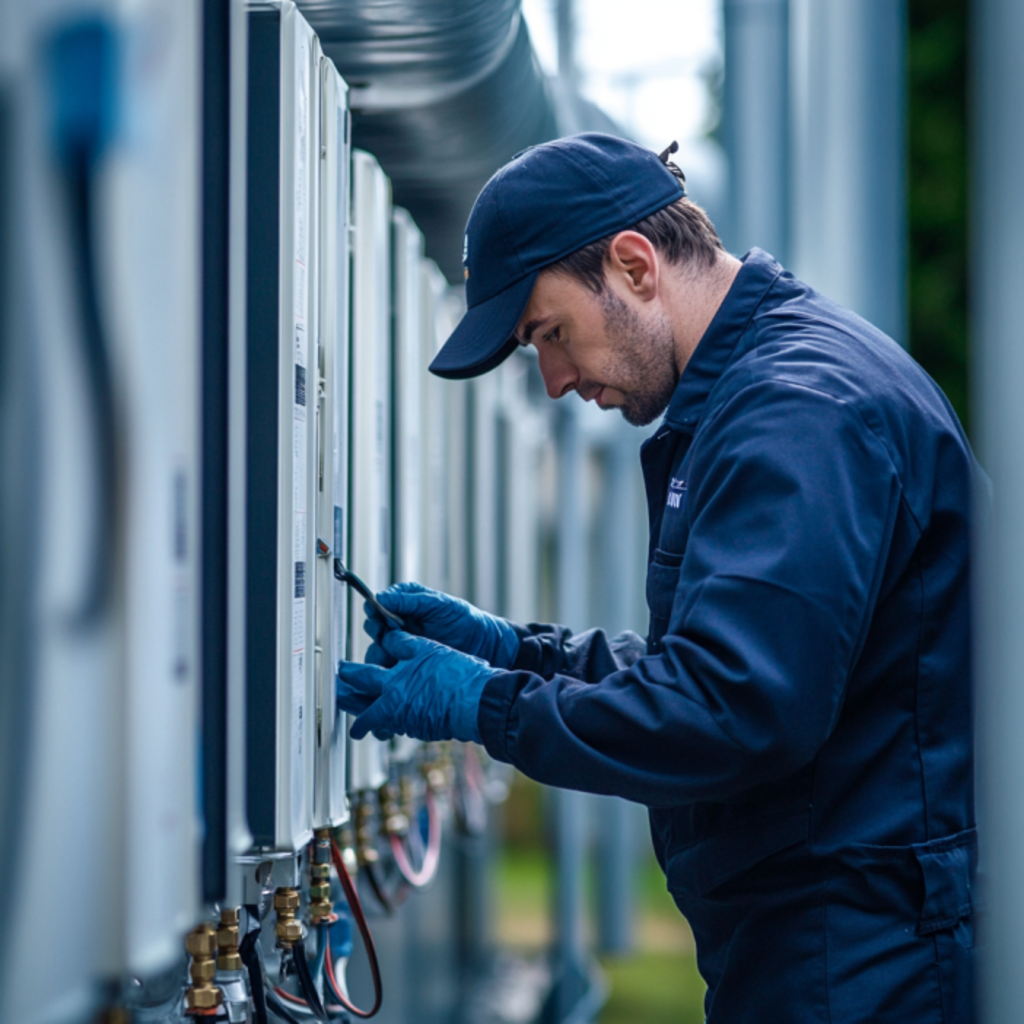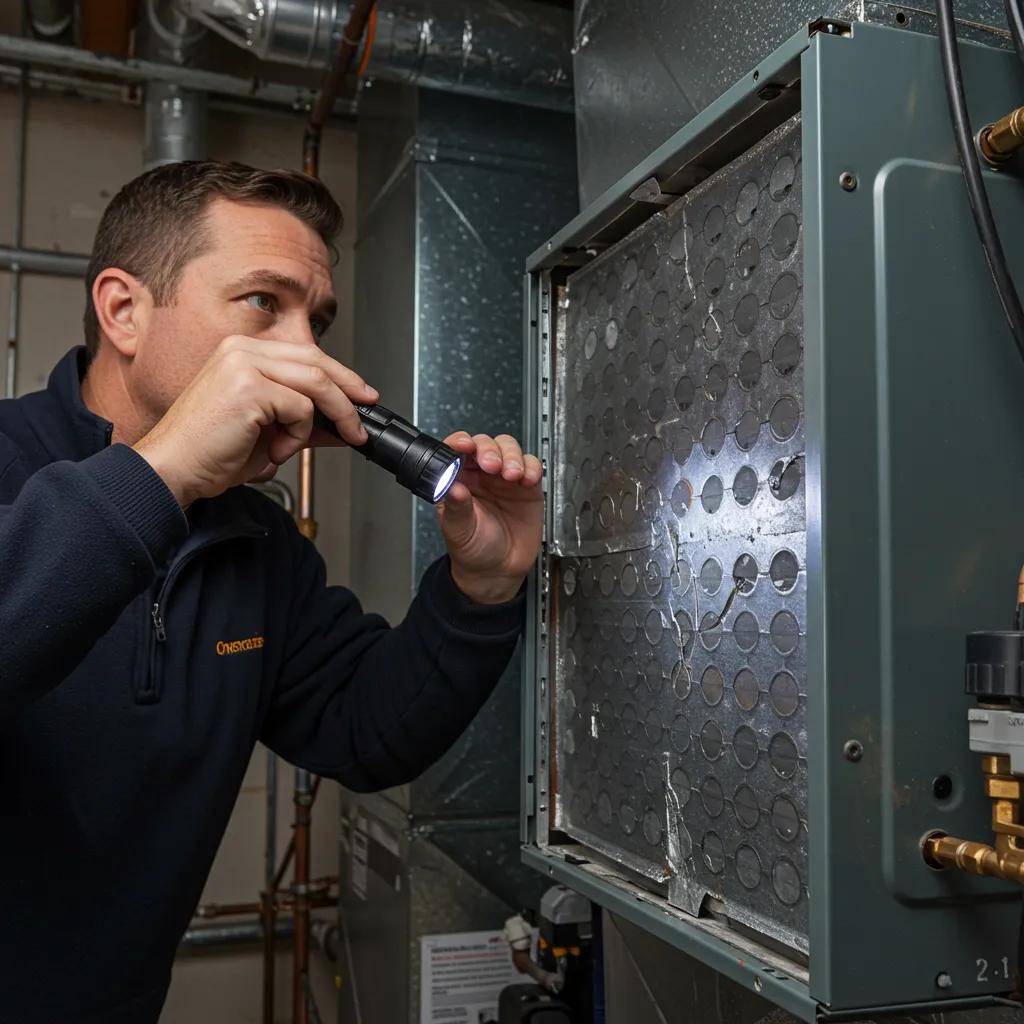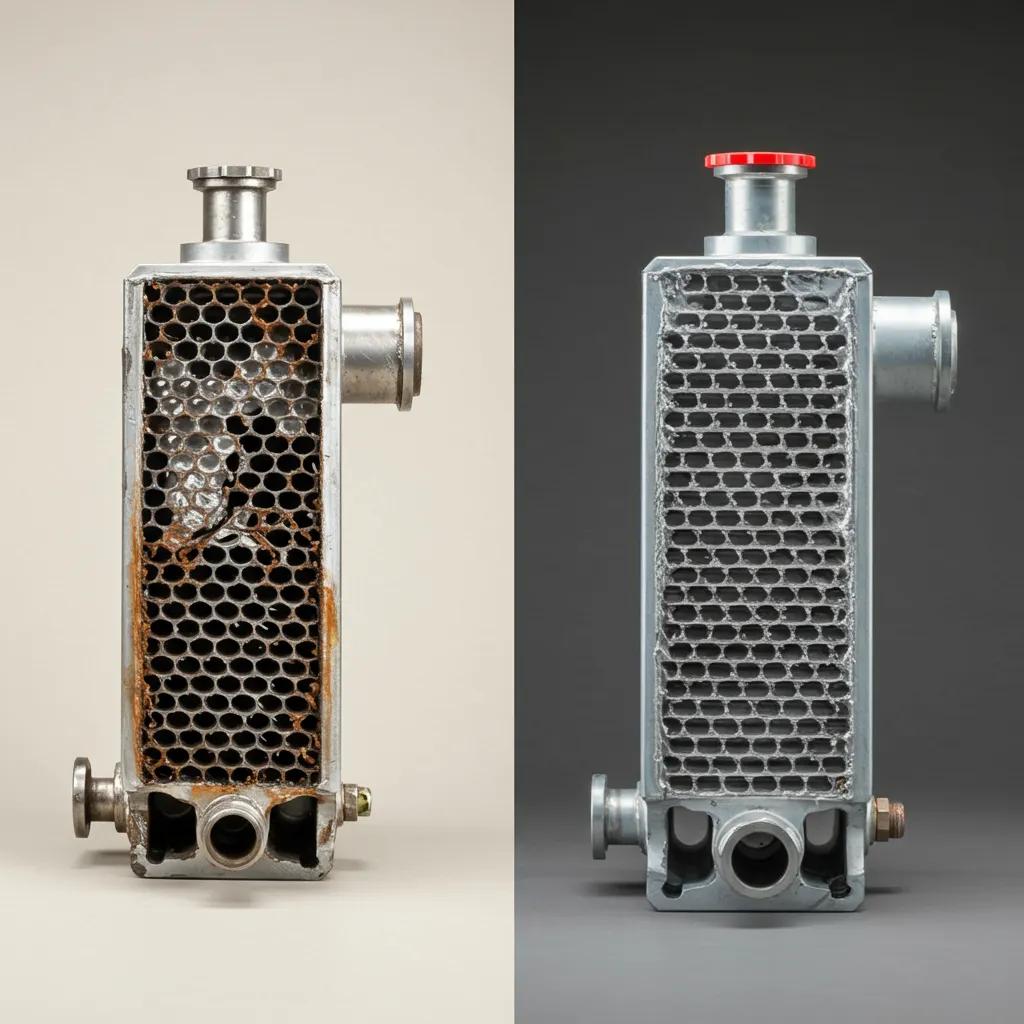
Troubleshooting Your HVAC Heat Exchanger: Spotting Issues, Finding Causes, and Ensuring Safe Operation
A furnace or boiler with a faulty heat exchanger is a serious concern, potentially leading to dangerous carbon monoxide leaks and inefficient heating. For homeowners and businesses in Plant City, FL, recognizing early signs of cracks or corrosion is key to preventing safety hazards and costly disruptions. This guide will walk you through how a furnace heat exchanger works, the tell-tale signs of a failing unit, common reasons for damage, and how to decide between repair and replacement. We’ll also cover the expert inspection, repair, and preventative maintenance services offered by Creamer Air Conditioning & Heating, your trusted partner for reliable heating and long-term safety.
What Exactly Is a Heat Exchanger and Why Is It Crucial for Your HVAC System?
Think of a heat exchanger as the heart of your furnace or boiler. It’s a specially designed metal component that efficiently transfers heat from the combustion process to your home’s air or water, all while keeping the exhaust gases safely contained within the unit. As fuel burns, the exchanger’s internal tubes or plates absorb this heat and channel it into your ductwork or radiators. Crucially, it ensures that the combustion by-products never mix with the air you breathe, preventing carbon monoxide from entering your living space and maximizing energy efficiency. A well-built heat exchanger is vital for maintaining comfortable temperatures and resisting the wear and tear of constant heating cycles.
Here are the common types of heat pumps found in residential heating systems:
- Plate-and-frame exchangers: Ideal for boilers, these use stacked plates to manage water flow.
- Tubular exchangers: These feature straight or coiled tubes that carry the heat from combustion in furnaces.
- Shell-and-tube units: In these, exhaust gases flow through a bundle of tubes surrounded by water or air.
- Micro-channel exchangers: Often found in modern, energy-efficient electric boilers, these use very small channels for enhanced heat transfer.
Regardless of their specific design, all these exchangers share the critical job of separating combustion gases from your home’s air while efficiently moving heat. Understanding this fundamental role helps in identifying when something isn’t working right.
What Are the Warning Signs of a Damaged or Cracked Heat Exchanger?

Catching heat exchanger problems early is your best defense against carbon monoxide risks and wasted energy. You might notice several indicators, including visual cues, unusual sounds, strange smells, or a noticeable drop in your system’s performance.
What Visual Clues Point to a Cracked Furnace Heat Exchanger?
Specialized inspection tools can reveal subtle issues like hairline cracks, rust spots, soot buildup, or discoloration along the exchanger’s seams. If you see dark, uneven patches near weld points, it could mean flue gases are escaping. Deterioration is also indicated by brittle edges on metal panels or flaking material, signs that the metal is weakening under constant heat cycles.
What Sounds Might Signal Heat Exchanger Issues in Your Furnace or Boiler?
Listen for rattling or popping noises when your system starts up; this often means metal parts are expanding unevenly and hitting the housing. In boilers, a “kettling” sound can occur due to mineral buildup on the heat transfer surfaces, causing localized overheating and potential cracking. Persistent banging during operation might suggest loose or warped components struggling under combustion pressure.
This kind of mechanical failure is frequently linked to how the material reacts to repeated heating and cooling cycles.
Common Heat Exchanger Failures: Causes and Prevention
The investigation revealed that the root cause of tube failure was thermal fatigue. A number of recommendations for preventing this failure were put forward, including revised boiler design, improved material selection, and optimised operating conditions. Regular inspection and maintenance are crucial for preventing such failures.
Are There Unusual Smells That Indicate Heat Exchanger Damage?
A sharp, chemical odor, sometimes described as formaldehyde-like, can signal flue gases escaping through tiny cracks and mixing with household dust. A burning metal smell might indicate the exchanger is starting to oxidize internally. Any strange sulfurous or unusually sweet metallic scent should prompt an immediate call to a professional.
How Do Performance Problems and CO Alarms Point to Heat Exchanger Faults?
If your furnace flames are flickering yellow instead of a steady blue, it suggests incomplete combustion due to an air-fuel imbalance, possibly caused by cracks. A noticeable decrease in heating output, unexpected water pooling around the unit, or your carbon monoxide detectors sounding are definitive signs that toxic gases are escaping into your home. These symptoms require urgent attention to restore safe operation.
Being aware of these combined symptoms helps prevent further damage and guides technicians toward accurate diagnoses and effective solutions.
What Causes Heat Exchanger Problems, and How Can You Prevent Them?
Understanding the root causes of furnace heat exchanger cracks is essential for developing effective prevention strategies. Factors like thermal fatigue, corrosion, buildup (fouling), and restricted airflow all contribute to the degradation of metal integrity over time.
| Type of Failure | What Causes It | How to Prevent It |
|---|---|---|
| Thermal Stress | Constant expansion and contraction during heating cycles | Maintain consistent operating cycles and avoid rapid temperature changes. |
| Corrosion | Chemical reactions from condensation or acidic by-products | Use water treatment solutions and consider water softening systems. |
| Fouling | Accumulation of scale, sludge, or soot | Schedule regular system cleanings and replace air filters promptly. |
| Poor Airflow | Blocked vents or dirty air filters | Change air filters every three months and ensure vents are clear. |
The specific stresses and material degradation common in gas boilers can lead to significant cracking issues.
Root Cause Analysis of Cracked Heat Exchangers in Gas Boilers
The purpose of this study is to analyse the root cause of cracking in the heat exchanger of gas wall-hung boilers and to develop an effective and universally applicable failure analysis process. In this study, root cause analysis (RCA) was performed on a cracked primary heat exchanger from a gas wall-mounted boiler to identify the underlying causes of failure. The analysis involved examining the material properties, operating conditions, and failure mechanisms.
When these issues are ignored, they significantly shorten the lifespan of your heat exchanger. A proactive maintenance plan that addresses these potential problems can extend its life, keep your system running efficiently, and minimize safety risks.
Why Is a Carbon Monoxide Leak from a Faulty Heat Exchanger So Dangerous?
Carbon monoxide (CO) is a dangerous gas produced when fuel doesn’t burn completely. It’s invisible and odorless, but it can be deadly because it binds to your blood’s hemoglobin much more easily than oxygen. Even low levels of exposure can cause headaches, nausea, and dizziness. Higher concentrations can quickly lead to unconsciousness and even death.
Watch out for these potential carbon monoxide poisoning symptoms:
- Constant headaches or feeling lightheaded
- Nausea or vomiting without any other signs of illness
- Difficulty breathing or chest pain during light activity
- Confusion, unusual tiredness, or vision problems
If you suspect a CO leak, turn off your heating system immediately, open windows to ventilate the area, and have everyone leave the building. Then, call for professional help. Our technicians use specialized combustion analyzers and calibrated CO detectors to pinpoint leaks and ensure your system is safe to operate again.
How Do You Decide Whether to Repair or Replace Your Heat Exchanger?

The decision to repair or replace a cracked heat exchanger depends on several factors: the age of your unit, how severe the damage is, whether it’s still under warranty, and your long-term efficiency goals. Repair might be a good option if the cracks are minor, the exchanger is relatively new, and replacement parts are readily available. However, if the cracks are deep, corrosion is widespread, or the unit is nearing the end of its typical lifespan, replacement might be the more sensible choice.
Here are typical cost considerations for Plant City, FL residents:
- Repairing a heat exchanger, including parts and labor, typically costs between $400 and $700.
- Replacing the entire heat exchanger, with parts and labor, usually ranges from $900 to $1,500.
- A full furnace or boiler replacement, including installation of a high-efficiency model, can start around $3,000.
| Option | Key Advantages | Key Disadvantages |
|---|---|---|
| Repair | Lower upfront cost, faster completion | May not fully restore efficiency, limited warranty on repairs |
| Exchanger Replacement | Extends system life, restores efficiency, comes with a new warranty | Higher initial investment, may require more scheduling time |
| Full Unit Replacement | Provides the latest technology and maximum efficiency gains | Highest upfront cost, requires potential system recalibration |
Considering that many residential and industrial systems are quite old, understanding standard repair procedures is crucial for addressing failures effectively.
Standardised Repair Procedures for Heat Exchanger Failures
Failures of shell and tube heat exchangers during service have been a significant cause of petrochemical plant turnarounds and shutdowns. Such failures not only interrupt production operations and substantially impact financial losses but also necessitate immediate attention regarding different types of repairs and maintenance. Welding repair has recently become a significant concern, as numerous process facilities have been in operation for over 40 years, with the oil and gas refining sector being a global pioneer. Heat exchanger materials have lost strength and toughness due to degradation such as temper embrittlement and galvanic corrosion, as well as other forms of damage including pitting corrosion, excessive wear, fatigue failure, and creep, resulting from continuous long-term operation. This paper discusses the standardised welding procedures for heat exchanger failures occurring during turnaround periods or due to aged conditions across various end-users worldwide.
Discussing these options with a certified technician will help you find the best balance between your budget and your long-term heating services performance needs.
What Expert Heat Exchanger Services Does Creamer Air Conditioning & Heating Provide?
As your local HVAC specialists, Creamer Air Conditioning & Heating offers thorough diagnostics, safe repair solutions, and dependable replacement services, all customized for Plant City homeowners and businesses.
How Does Creamer AC Pinpoint Heat Exchanger Issues?
Our technicians perform detailed visual inspections and use advanced combustion analysis to measure flue gas composition, effectively detecting leaks and inefficiencies. Thermal imaging helps us identify hot spots or uneven heating across the exchanger surfaces. We also conduct pressure and airflow tests to ensure your system is properly sized and that filters aren’t impeding performance.
What Repair and Replacement Options Does Creamer AC Offer?
For minor cracks or issues confined to welds, our skilled technicians can perform precise welding and patching to restore the exchanger’s integrity. If corrosion is extensive or damage is widespread, we offer complete exchanger replacements to ensure full containment of combustion by-products. All our work strictly follows safety standards and manufacturer guidelines to protect your warranty and system certification.
How Can Regular Maintenance Keep Your Heat Exchanger in Top Shape?
Our annual maintenance plans include cleaning exchanger surfaces, applying protective corrosion inhibitors, replacing filters, and calibrating airflow. This preventative care significantly reduces the buildup of damaging deposits, combats thermal fatigue, and allows us to spot early signs of wear before cracks can even form.
These comprehensive services are designed to ensure your heating system operates safely and efficiently, helping you avoid unexpected breakdowns and hazardous carbon monoxide exposure.
What Are the Most Common Questions About Heat Exchanger Problems?
Many property owners seek clear answers about how serious symptoms are, whether repairs are feasible, and what safety measures to take. Frequent questions revolve around identifying cracks, comparing repair costs, and the immediate steps to follow if a carbon monoxide alarm sounds. Our experienced technicians always stress that any indication of flue gas escaping requires professional assessment to determine if a simple repair or a full replacement is the most reliable solution.
How Can You Schedule a Heat Exchanger Check-up or Repair with Creamer Air Conditioning & Heating?
Booking a service appointment with us is straightforward and efficient. Simply contact Creamer Air Conditioning & Heating by phone or through our online form, providing details about your heating system and any symptoms you’ve observed. Our certified local specialists will confirm your appointment, arrive fully equipped with diagnostic tools, and recommend the most effective repair or replacement plan. Prompt service minimizes downtime and quickly restores safe, efficient heating to your Plant City home or business.
- When requesting service, please provide your system type, model number, and a summary of the issues.
- Ensure clear access to your furnace or boiler area for a thorough inspection.
- Review the technician’s findings and approve the recommended repair or replacement options.
- Consider signing up for our annual maintenance plan to prevent future heat exchanger problems.
Consistent professional servicing and expert guidance will keep your heat exchanger operating safely and efficiently for years to come.
In conclusion, understanding how your heat exchanger works and recognizing the signs of potential failure empowers you to take action before safety risks become critical. Creamer Air Conditioning & Heating combines cutting-edge diagnostic technology, skilled repair techniques, and proactive maintenance plans to safeguard your property from carbon monoxide hazards and ensure reliable heating performance all season long. Schedule your professional service today for guaranteed peace of mind and optimal comfort.



